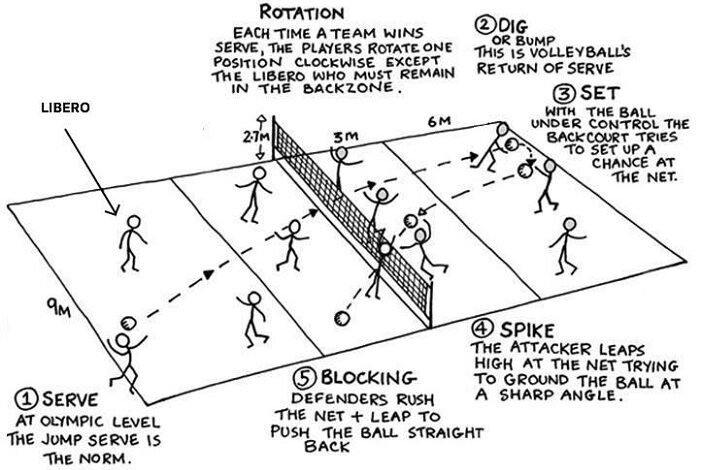
Volleyball is a fast-paced and exciting sport, but to truly appreciate the game, it’s essential to understand the different positions on the court. Each player has a specific role, and knowing these positions can help you follow the game better or improve your own play. In this post, I’ll break down the key volleyball positions in simple terms.
What Are the Positions in Volleyball?
In volleyball, there are six main positions, each with its own unique responsibilities. Whether you’re playing in a competitive match or just enjoying a casual game with friends, understanding these positions will help you play more effectively.
1. Outside Hitter (Left-Side Hitter)
- Role: The outside hitter is often the go-to attacker on the team. They play on the left side of the court and are responsible for spiking the ball, blocking, and playing defense. Outside hitters need to be versatile because they are involved in both offense and defense.
- Key Skills: Strong hitting, good blocking, and reliable passing.
2. Opposite Hitter (Right-Side Hitter)
- Role: The opposite hitter plays on the right side of the court and is another key attacker. They are positioned to block the opposing team’s outside hitters and provide support in attacking and serving. This player is often the backup setter if needed.
- Key Skills: Powerful spikes, solid blocking, and good all-around play.
3. Setter
- Role: The setter is the playmaker of the team. They set up the ball for the hitters, deciding where the ball will go for the next attack. The setter needs to be quick, accurate, and able to read the game well.
- Key Skills: Precise setting, quick decision-making, and strong leadership.
4. Middle Blocker (Middle Hitter)
- Role: Positioned in the center of the front row, the middle blocker’s main job is to stop the other team’s attacks by blocking. They also perform quick attacks and need to be fast to cover both sides of the net.
- Key Skills: Height, jumping ability, and excellent timing.
5. Libero
- Role: The libero is a defensive specialist who wears a different colored jersey and can substitute for any back-row player. The libero’s job is to receive serves, dig attacks, and pass the ball accurately to the setter. They don’t attack or serve.
- Key Skills: Superior passing, quick reflexes, and strong defensive play.
6. Defensive Specialist
- Role: Similar to the libero, a defensive specialist focuses on playing defense. They usually replace a front-row player when that player rotates to the back row. This position adds extra defensive strength without the restrictions of a libero.
- Key Skills: Good passing, strong digging, and situational awareness.
How Players Rotate in Volleyball
Volleyball is unique because players rotate clockwise every time their team wins a point while serving. This means that each player will play each position during the game, except for the libero, who stays in the back row. Understanding this rotation helps players adapt to different roles and keeps the game dynamic.
Conclusion
Whether you’re just getting into volleyball or looking to improve your understanding of the game, knowing the different positions is key. Each position plays a crucial role in the team’s success, and mastering your role can make you a more valuable player. Keep these positions in mind the next time you watch or play volleyball – it’ll make the game even more enjoyable!





